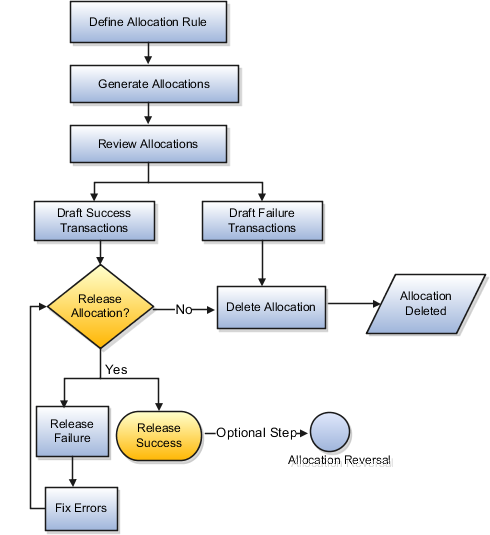How Project Cost Allocations are Processed
Allocations are processed to distribute various types of costs to distinct sets of target projects and tasks. You identify the amounts to allocate and then define targets, projects and tasks to which you want to allocate the source amounts.
Optionally, you offset the allocations with reversing transactions. Oracle Fusion Project Costing gathers source amounts into a source pool and then allocates to the targets using the basis method that you specify in the allocation rule. When the allocation is released, expenditure items are created and processed.
Here's a flowchart that shows how project cost allocations are processed.

Settings That Affect Project Cost Allocation Processing
You create a set of allocation rules to allocate various types of costs to distinct sets of target projects and tasks. Allocation transactions are generated based on the settings in the allocation rules such as:
-
Allocation or offset transaction attributes
-
Source amounts to allocate
-
Target projects and tasks to allocate source amounts
-
Allocation method
-
Offset method to reverse and balance allocation transactions
-
Basis method
Each allocation rule is associated with a business unit. Source projects and ledger accounts of an allocation must be from the same business unit as the one that is assigned to the allocation rule. During processing, based on the target selection, if the project cross-charge is enabled, costs can be allocated costs to projects across business units. However, offset transactions are charged to projects owned by the same business unit that owns the allocation rule.
How Project Cost Allocations Are Processed
When the allocation rule is prepared to generate allocations, costs are collected against the source. For project sources, the actual cost transactions are summarized and for ledger sources, journal entries are posted for the source ledger accounts. If a prorate basis method is used, then ensure that either actual cost or budget amounts are summarized for the target projects, depending on the prorate logic. The allocation is generated either once in an accounting period or incrementally in the accounting period.
The resulting allocation transactions are draft allocations in draft success or draft failure statuses, which are displayed in the Manage Allocations page. The application tracks the source amount, currently and previously allocated amounts so that the user can review if the source amount is allocated appropriately. Based on the type of basis method the allocation rule uses, the application provides the basis percentage and effective percentage. The allocation generation errors are tracked and displayed as exceptions. You can review the issues and fix them as required. If the allocation rule uses an incremental allocation method, then the missing amounts are tracked and you can determine differences from the previous allocation. For example, if a target project that received an allocation transaction during the previous allocation is now closed, then that the amount previously allocated to that project appears as a missing amount. If the draft allocations are as per your expectation, the allocation and offset transactions can get released, which results in the creation of expenditure items. The draft successful transactions can fail during the release of an allocation. For example the released transaction may violate a transaction control. You can fix the errors and then release the allocation.
The draft failure allocations are processed only after reviewing and fixing the issues. For example, you can edit the associated allocation rule or ensure that the actual amounts are summarized for source projects. After fixing the errors, delete the draft allocation and generate the allocation again.